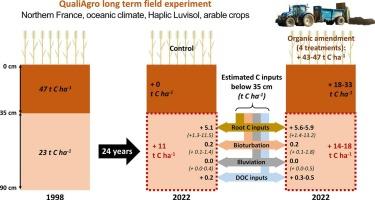施用有机改良剂20年后,土壤下层有机碳储量的增加不能用多种碳输入的估计贡献来解释
IF 6.6
1区 农林科学
Q1 SOIL SCIENCE
引用次数: 0
摘要
土壤有机碳(SOC)对土壤健康和减缓气候变化具有重要意义。众所周知,有机改进剂(OA)的应用会增加有机碳储量。然而,现有的研究大多集中在表层土壤上,而底土是土壤有机碳的重要来源。在本研究中,我们量化了经过24年OA应用后,qualagro长期实验中0-90 cm的SOC储量积累。土壤有机碳储量仅在施用有机酸时增加,而在施用有机酸和不施用有机酸时,土壤有机碳储量均显著增加。与对照相比,施用有机酸增加了地下土壤有机碳储量:35-50 cm和50-90 cm土层的有机碳储量分别从5%增加到10%和3%增加到13%。对地下土层的碳输入进行了估算:利用作物产量和异速生长系数估算地下作物的碳输入,通过直接测量(溶渗仪)估算溶解有机碳(DOC)淋失,通过土壤薄片图像分析估算光照和生物扰动。潜在碳输入不能完全解释土壤有机碳累积。地下作物C对土壤有机碳储量的贡献从32%到54%不等。DOC浸出的贡献有限(1 ~ 5%)。生物扰动和光照的贡献非常有限(≤3%)。我们的研究表明,我们目前对土壤有机碳影响机制的理解存在差异,并强调了在监测OA应用对土壤有机碳储量的影响时考虑土壤的重要性。本文章由计算机程序翻译,如有差异,请以英文原文为准。

Increase in organic carbon stocks in subsoil layers after two decades of organic amendment application cannot be explained by the estimated contribution of multiple C inputs
Soil organic carbon (SOC) is important for both soil health and climate change mitigation. Organic amendment (OA) applications are known to increase SOC stocks. However, most existing studies have focused on surface soil layers, whereas the subsoil is an important SOC stock. In this study, we quantified SOC stock accrual over 0–90 cm in the QualiAgro long-term experiment after 24 years of OA application. While surface SOC stocks increased only with OA application, they increased significantly in the subsoil both with and without OA application. Compared to the control, OA application increased subsoil SOC stocks: from 5 % to 10 % and from 3 % to 13 % of the total SOC stocks accrual over the whole soil profile occurred in the 35–50 cm and 50–90 cm soil layers, respectively. C inputs to the subsoil layers were estimated: belowground crop C inputs using crop yields and allometric coefficients, dissolved organic carbon (DOC) leaching by direct measurement (lysimeter), illuviation and bioturbation by image analysis of soil thin sections. Potential C inputs did not fully explain the subsoil SOC stocks accrual. The contribution of belowground crop C ranged from 32 % to 54 % of the SOC stocks accrual. DOC leaching showed a limited contribution (1 to 5 %). The contribution of bioturbation and illuviation was very limited (≤3%). Our study suggests discrepancies in our current understanding of the mechanisms influencing subsoil SOC, and highlights the importance of considering the subsoil when monitoring the effect of OA application on SOC stocks.
求助全文
通过发布文献求助,成功后即可免费获取论文全文。
去求助
来源期刊

Geoderma
农林科学-土壤科学
CiteScore
11.80
自引率
6.60%
发文量
597
审稿时长
58 days
期刊介绍:
Geoderma - the global journal of soil science - welcomes authors, readers and soil research from all parts of the world, encourages worldwide soil studies, and embraces all aspects of soil science and its associated pedagogy. The journal particularly welcomes interdisciplinary work focusing on dynamic soil processes and functions across space and time.
 求助内容:
求助内容: 应助结果提醒方式:
应助结果提醒方式:


